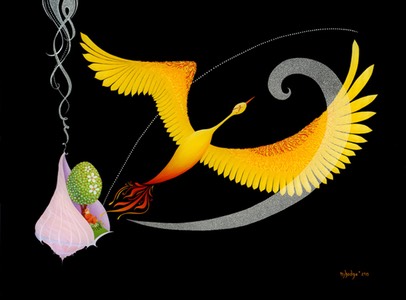It's spring again and every spring I go back to my roots in the Croatian Naive - making connections between the seasonal lives of the early peasant-painters in this tradition and my own studio to garden balance. As such, I have decided to post one the notes for my upcoming exhibition today, celebrating some of the reasons why I love the Croatian Naive and why I feel so grounded within its history.
To start off with, the reveal of 'Phoenix Dreams'*: a painting that seeks to express, in some small part, how my dreaming self strives to breathe new life into an old technique.

The Croatian Naive began as an experiment in 1929 when an Academy trained and early proto-type of the artist-activist, Krsto Hegedušić, encouraged boys in the village of Hlebine ‘to paint what they saw.’ In the decades following the artists moved from canvas to painting on glass and three further generations of artists have taken the Croatian Naive from the bleakness of subsistence farming to the edges of surrealism and back again, via the cutting edges of pop art and massive auction successes. Today though the Croatian Naive is a fading tradition and the artists nearly forgotten.
For me, however, the Croatian Naive began the day I first visited the studio of the Naive painter, Ivica Fišter. Despite my poor and haphazard Croatian language skills, he introduced me to the basic techniques of the medium and then encouraged me to learn more about the tradition and other artists. Through Ivica I met Katarina Krvarić who, after Ivica, has had the profoundest impact on my work. Together, with the artist Željko Seleš, these three artists have shaped who I am as an artist and how I work on a daily basis.
In addition to a warm welcome and encouragement as I started learning more about the tradition, the Croatian Naive has offered me an iconography of visual motifs which have inspired me and which continue to appear in my own works even though I have no memory of borrowing them intentionally. From over-sized flowers blossoming out of season, to animal totems and landscapes re-imagined before my eyes, the Croatian Naive opened my eyes to a new way of looking at the world and gifted me the means with which I might express myself more fully.
Lastly, the Croatian Naive has given me a personal history grounded in a wider picture: like the early peasant-painters I received very little training in the technique and from early on was told to find my own answers to the questions I asked. Like them too I have been inspired by the foothills, vineyards, mountains and islands of the Croatian landscape, and I have used those views as the springboard for my own imagined and interpreted dreamscapes. And in a twist of fate that felt like a homecoming, and which was discovered only after the fact, I too hung my first exhibitions on the walls of the Ullrich family gallery - only 75 years on from those first Naive painters.
It is in all of these ways that I am grounded in the Croatian Naive: in the technique, the tradition and a shared history; in the land and landscape; in how I approach my work and tend my garden; in my appreciation of a supportive arts community; and in a shared aesthetic that travels across generations. For me, the Croatian Naive is a living and lively conversation and my paintings are just the next line of dialogue, waiting to happen.
*
Should you come to see my upcoming exhibition, Through a Looking Glass, do be prepared: 'Phoenix Dreams' has been framed in white to better show off it's shadows through the clear glass background. The black background pictured above is for the print version only: this painting, at least, has a more photogenic doppelganger. The difference in effects is striking to say the least - to find out more please read my blog post Doppelgänger Duality.